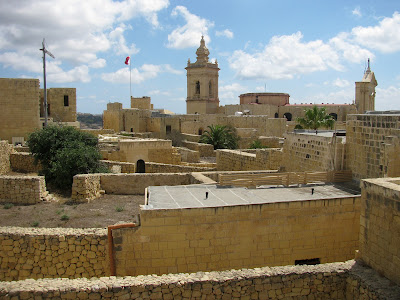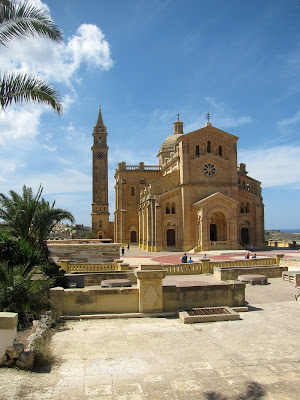Malta turned out to be the perfect choice for us. A small island country, it is located in the central Mediterranean Sea, south of Sicily and north of Libya. The country consists of five islands - Malta, Gozo and Comino, which are inhabited, and the uninhabited islands of Cominotto and Filfla. The capital and chief port is Valletta, which is located on the main island of Malta.
Valletta was founded in 1566 by the
Knight of the Order of St. John
who was called Jean Parisot de la Valette. The city has lovely narrow streets
and historic buildings dating back to the 16th century, as well as quaint
gardens, parks and artfully decorated churches. At just 0.61 square
kilometres, it is the European Union's smallest capital city and therefore
very walkable. We spent our days exploring the streets and museums of the
city, returning towards the end of each day to our gorgeous hotel, The Embassy Valletta Hotel, situated
right in the heart of Valletta, for a swim in their rooftop pool, top photos.
It had the most incredible views!
We visited the
St. Elmo National War Museum
which charts Malta's history from early civilization through the Knights
period and the victory over the Ottomans, the first and Second World Wars
and onto independence. The museum is within the actual fort of St. Elmo
and enjoys great views of the harbours from every direction.
The Lascaris War Rooms,
above, housed the war headquarters from where the defence of Malta was
conducted during the Second World War. The rooms are now open to the public
as a museum.
The one day that required us to get up early and get moving was when we
took a ferry over to the island of Gozo. We booked tickets for the hop on
hop off bus and spent a long day (we took the very last bus of the day
back to the harbour!) stopping at all the island's major attractions. My
favourite stop was at Dwejra Bay, a rugged island bay featuring
beautiful rock formations which we saw on a short boat ride to the Blue
Grotto, above. The water was an unreal shade of cobalt blue, and the coral
and algae made beautiful purple-green stripes on the rocks.
The
Ġgantija temples, above, are the earliest of the megalithic temples of Malta and are older
than the pyramids of Egypt. The name Ġgantija derives from the word 'ġgant',
Maltese for giant, as Gozitans used to believe the temples were built by a
race of giants. Not so surprising when you see the size of the limestone
blocks from which they are constructed. Some of these megaliths exceed five
metres in length and weigh over fifty tonnes.
We took a traditional Maltese water taxi called
a dgħajsa across the harbour, to explore Vittoriosa,
Senglea and Cospicua, known as the Three Cities of Malta. These types of
boats have navigated the Grand Harbour since the 17th century and
continue to serve as the main way to travel back-and-forth.
The Three Cities sit directly across the Grand Harbour from Valletta.
Although they are three cities, they are relatively small and clustered
together, making it very easy to sight-see in just a few hours. The area was
picturesque and full of history, though I regretted not joining a walking
tour for our visit.
The Gardjola Gardens, above, a small park at the end of the Senglea
peninsula, provided us with a spot to relax in the shade while enjoying the
impressive views over the harbour and the city of Valletta.
Mdina is a fortified town located on a large hill in the centre of Malta. It
served as the island's capital until the medieval period. The town is still
built within its walls and has a population of just under 300. With its
narrow streets, few inhabitants and incredible views overlooking large parts
of Malta, Mdina is extraordinary in its mix of medieval and baroque
architecture. It was also one of the filming locations for Game of Thrones!
The
Co-Cathedral of St. John
was one of the last places we visited but was certainly worth the wait! It
is a Roman Catholic co-cathedral (Malta's population is 98%
Catholic) in Valletta, dedicated to Saint John the Baptist. It was
built by the Order of St. John between 1572 and 1577. In the 17th century
the interior was redecorated in the
Baroque
style and today it is considered to be one of the finest examples of
high Baroque architecture in Europe. Incredibly, the cathedral survived the
heavy bombing of Malta during the Second World War.
The cathedral also houses one of Europe's most impressive and famous artworks - Caravaggio's Beheading of St. John the Baptist - widely considered to be one of the ten greatest works of art of all time. It was definitely a highlight of our week-long trip to Malta.
The cathedral also houses one of Europe's most impressive and famous artworks - Caravaggio's Beheading of St. John the Baptist - widely considered to be one of the ten greatest works of art of all time. It was definitely a highlight of our week-long trip to Malta.
* This post has been shared on
The Good. The Random. The Fun., Wordless Wednesday (on Tuesday) and
My Corner of the World.












































.png)

































